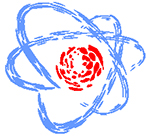Speaker
Mr
Karol Bolek
(Warsaw University of Technology)
Description
Radon - as an alpha-radioactive gas naturally present in atmospheric air - is the main component of the exposure of Poles to ionizing radiation, accounting for almost 40% of the annual effective dose and over 70% of the dose received by a statistical Poles.
One of the commonly used passive methods for measuring radon concentrations in the air is the CR39 type Solid State Nuclear Tracker (SSNTD), a commercial name for allyl diglycol polycarbonate (PADC). These are small plates which, when measured, are placed in appropriately sized containers of known volume and then, after appropriate thermochemical treatment, are analyzed under a microscope. Particles of alpha, protons and heavy ions passing through the detector material damage the chemical bonds, which can be visualized by thermochemical treatment. As a result of etching on the plates are formed holes.
Preparing of map radon gas concentration in buildings of Warsaw University of Technology (WUT) contain:
1. Arrangement of CR39 detectors in buildings WUT
2. Preparation of measuring system
3. Research on optimization of thermochemical process
4. Measurement execution
5. Preparing an interactive concentration map
All research was done in cooperation with the science club CAMAC from the Faculty of Physics and the science club Chemical and Process Engineering (IChiP) from the Faculty of Chemical and Process Engineering WUT as part of the Rector's grant.
Author
Mr
Karol Bolek
(Warsaw University of Technology)
Co-authors
Mr
Michał Miler
(Warsaw University of Technology)
Nina Borzęcka
(Warsaw University of Technology)
Zuzanna Podgórska
(Central Laboratory for Radiological Protection, Warsaw University of Technology)

